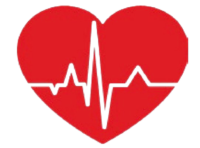Cardiac Health Teams
About Us
Welcome to Cardiac Health Team Centre, where we specialize in delivering exceptional cardiac services through state-of-the-art diagnostic tests and expert cardiology consultations. Our unwavering mission is to minimize waiting times for cardiology services in Ontario, ensuring swift access without compromising the highest standards of quality and accuracy. Elevating the standard of care, we proudly offer unique services previously unavailable in Sudbury, including stress echocardiography and pediatric echocardiography. Our dedicated and specialized staff members are committed to providing unparalleled expertise in these specialized tests. Contact us today to discover a new era in cardiac care, where efficiency meets excellence
Take a look at our provided services
Transthoracic Echocardiogram (TTE): Understanding Your Heart Health
Transthoracic Echocardiogram (TTE): Understanding Your Heart Health
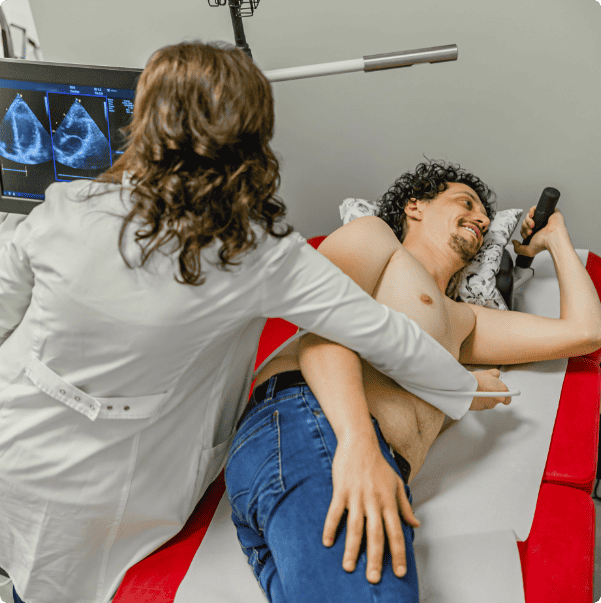
A Transthoracic Echocardiogram (TTE) is a non-invasive and painless cardiac imaging test that provides crucial insights into the structure and function of your heart. This diagnostic procedure uses high-frequency sound waves (ultrasound) to create detailed images of the heart chambers, valves, and surrounding structures.
What to Expect:
During a TTE, a small handheld device called a transducer is placed on the chest, emitting sound waves that bounce off the heart’s structures. The returning echoes are transformed into real-time images displayed on a monitor. This allows our skilled healthcare professionals to assess the size, shape, and movement of the heart, helping to identify any abnormalities.
Why It’s Done:
Diagnosis: TTE aids in diagnosing various heart conditions, including valve disorders, heart failure, and congenital heart abnormalities.
Monitoring: It is an invaluable tool for tracking the progression of certain heart conditions and assessing the effectiveness of treatments.
Guidance: TTE provides essential information for planning and guiding other cardiac procedures if needed.
Preparing for Your TTE:
Clothing: Wear comfortable, two-piece clothing to allow easy access to your chest.
Timing: The test usually takes about 30 to 60 minutes.
Post-Procedure: There is typically no downtime, and you can resume your normal activities immediately.
Results:
Your TTE results will be carefully analyzed by our expert cardiologists. The findings will be shared with you, and if necessary, further discussions about your treatment plan will be initiated.
Contact Us:
If you have any questions or concerns about your upcoming TTE or any other cardiac services, feel free to contact our team. We are dedicated to providing personalized, comprehensive care for your heart health
Contrast Transthoracic Echocardiogram (cTTE): Enhancing Heart Imaging Precision
Contrast Transthoracic Echocardiogram (cTTE): Enhancing Heart Imaging Precision
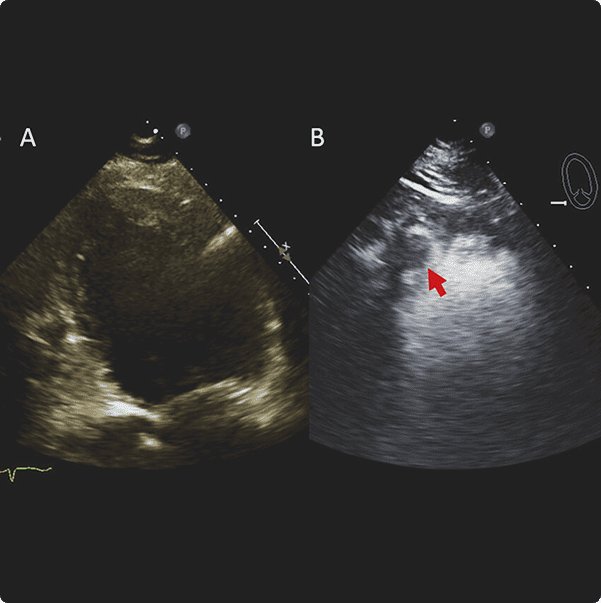
A Contrast Transthoracic Echocardiogram (cTTE) is an advanced cardiac imaging test that employs ultrasound and a contrast agent to obtain clearer and more detailed images of the heart. This diagnostic procedure enhances our ability to visualize and assess specific cardiac structures, providing valuable information for a comprehensive evaluation of your heart health.
How It Works:
During a cTTE, a contrast agent is introduced into the bloodstream through a vein, typically in the arm. This contrast material enhances the visibility of the heart chambers, allowing for a more precise and detailed examination.
What to Expect:
Injection: A trained healthcare professional will administer the contrast agent through a small needle in your arm.
Ultrasound: The ultrasound transducer is then placed on the chest to capture real-time images of the heart with enhanced clarity.
Duration: The procedure generally takes about 30 to 60 minutes.
Why It’s Done:
Improved Visualization: cTTE is particularly useful for obtaining clearer images in patients where standard echocardiography
may provide limited information.
Diagnostic Accuracy: It aids in the accurate diagnosis and assessment of various heart conditions, including structural abnormalities and heart valve disorders.
Preparing for Your cTTE:
Clothing: Wear comfortable, two-piece clothing to allow easy access to your chest.
Post-Procedure: There is typically no downtime after a cTTE, and you can resume your normal activities.
Results:
Your cTTE results will be thoroughly reviewed by our expert cardiologists, and a detailed report will be shared with you. If further discussions about your treatment plan are necessary, our team is here to provide guidance and support.
Contact Us:
If you have any questions or concerns about your upcoming cTTE or any other cardiac services, feel free to contact our team. We are dedicated to ensuring a comprehensive and personalized approach to your heart health.
Exercise Stress Echocardiography: Unveiling Your Heart’s Resilience
Exercise Stress Echocardiography: Unveiling Your Heart’s Resilience
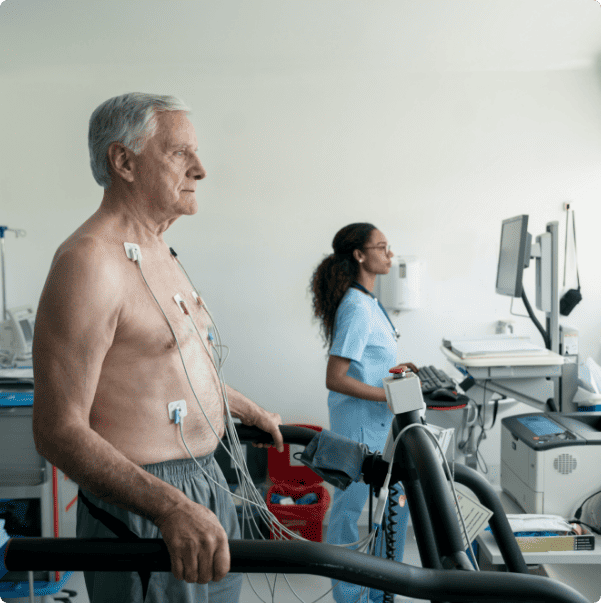
Exercise Stress Echocardiography is a specialized cardiac test designed to evaluate how your heart responds to physical activity. This dynamic procedure combines ultrasound imaging with exercise to provide comprehensive insights into your heart’s function and performance under stress.
How It Works:
Pre-Exercise: Resting ultrasound images of your heart are taken to establish a baseline.
Exercise Phase: You will be guided through a controlled exercise routine, typically on a treadmill or stationary bike, while your heart rate and blood pressure are monitored.
Real-Time Imaging: As you exercise, the ultrasound transducer captures real-time images of your heart, allowing us to assess blood flow, valve function, and overall cardiac performance during increased activity.
Why It’s Done:
Detecting Abnormalities: Exercise Stress Echocardiography is instrumental in detecting abnormalities that may only become apparent during physical exertion.
Assessing Fitness: It helps evaluate your heart’s response to exercise, providing valuable information about your overall cardiovascular fitness.
Preparing for Your Test:
Clothing: Wear comfortable exercise attire and sneakers.
Medication: Inform your healthcare provider about any medications you are taking, as some may need to be adjusted before the test.
Fasting: You don’t need to be fasting for this test.
During the Test:
Communication: Inform the technologist of any symptoms like chest pain, dizziness, or discomfort during the exercise phase.
Post-Test Guidelines: There is typically no downtime after Exercise Stress Echocardiography, and you can resume normal activities.
Results:
Your Exercise Stress Echocardiography results will be thoroughly analyzed by our expert cardiologists. A detailed report will be shared with you, and if further discussions about your treatment plan are necessary, our team is here to provide guidance and support.
Contact Us:
If you have any questions or concerns about your upcoming Exercise Stress Echocardiography or any other cardiac services, feel free to contact our team. We are dedicated to ensuring a comprehensive and personalized approach to your heart health.
Pediatric Echocardiography: Caring for Little Hearts
Pediatric Echocardiography: Caring for Little Hearts
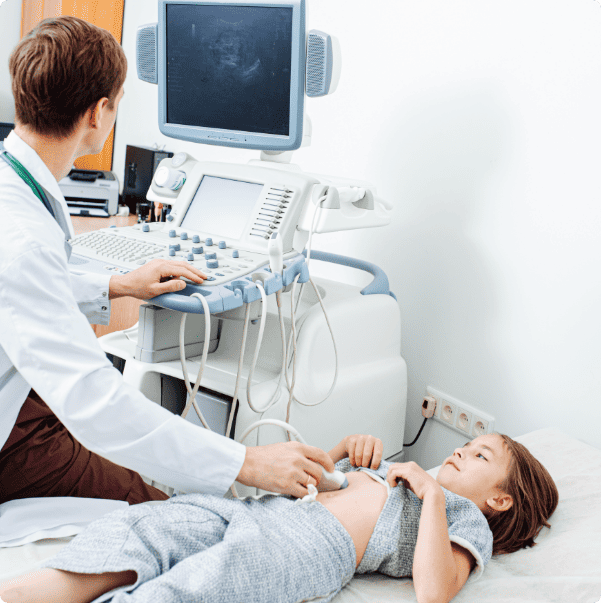
Pediatric Echocardiography is a specialized imaging test designed for infants, children, and adolescents to assess the structure and function of their hearts. This non-invasive procedure uses ultrasound technology to create detailed images, ensuring a comprehensive evaluation of your child’s cardiac health.
How It Works:
Non-Invasive Imaging: Pediatric Echocardiography utilizes ultrasound waves to create real-time images of your child’s heart, providing a clear view of its chambers, valves, and blood vessels.
Child-Friendly Approach: Our experienced and compassionate healthcare team is dedicated to creating a comfortable and reassuring environment for our young patients.
Why It’s Done:
Congenital Heart Conditions: Pediatric Echocardiography is instrumental in diagnosing and monitoring congenital heart conditions that may be present from birth.
Structural Assessments: It helps assess the structure and function of the heart, including the detection of any abnormalities or irregularities.
Preparing for Your Child’s Test:
Comfortable Attire: Dress your child in comfortable clothing, and we encourage bringing their favorite toy or comfort item.
Explanation: Depending on your child’s age, explaining the procedure in a simple and reassuring manner can help alleviate any anxiety.
During the Test:
Child-Centric Care: Our skilled technologists are experienced in working with children, ensuring a gentle and child-friendly approach during the entire procedure.
Parental Presence: Parents are often welcome to stay with their child throughout the test for added comfort and support.
Post-Test Guidelines: There is typically no downtime after Pediatric Echocardiography, and your child can resume normal activities.
Results:
Our expert pediatric cardiologists will thoroughly analyze the images and provide a detailed report. If further discussions about your child’s heart health or any necessary interventions are required, our caring team is here to support you.
Contact Us:
If you have any questions or concerns about your child’s upcoming Pediatric Echocardiography or any other pediatric cardiac services, feel free to contact our team. We are dedicated to providing specialized care for our youngest patients.
Holter Monitoring: A Window into Your Heart’s Rhythm
Holter Monitoring: A Window into Your Heart’s Rhythm

Holter Monitoring is a non-invasive and effective diagnostic test that records your heart’s electrical activity over an extended period, typically 1 day to 28 days. This continuous monitoring provides invaluable insights into your heart’s rhythm, helping our healthcare professionals identify irregularities that may not be captured during a brief office visit.
How It Works:
Wearable Device: You’ll be equipped with a small, portable device called a Holter monitor, which is connected to electrodes on your chest.
Continuous Recording: The monitor records your heart’s electrical activity continuously throughout the monitoring period, capturing data during your daily activities and sleep.
Why It’s Done:
Detecting Arrhythmias: Holter Monitoring is particularly effective in detecting irregular heartbeats (arrhythmias) that may occur sporadically.
Assessing Symptoms: If you experience symptoms such as palpitations, dizziness, or unexplained fainting, Holter Monitoring helps correlate these events with your heart’s electrical patterns.
Preparing for Your Holter Monitoring:
Clothing: Wear comfortable clothing as the monitor needs to be worn discreetly under your clothes.
Activity Log: Keep a record of your activities and symptoms during the monitoring period.
During the Test:
Normal Activities: Carry on with your usual daily activities, but avoid activities that may damage
the monitor (e.g., swimming or bathing).
Communication: Note any symptoms you experience and communicate them to your healthcare provider.
After the Monitoring Period: Return the Holter monitor as instructed by your healthcare team.
Results:
Your Holter Monitoring results will be carefully analyzed by our expert cardiologists. A detailed report will be shared with you, and if further discussions about your treatment plan are necessary, our team is here to provide guidance and support.
Contact Us:
If you have any questions or concerns about your upcoming Holter Monitoring or any other cardiac services, feel free to contact our team. We are dedicated to ensuring a comprehensive and personalized approach to your heart health.
Exercise Stress Electrocardiography (ECG): Assessing Your Heart’s Endurance
Exercise Stress Electrocardiography (ECG): Assessing Your Heart’s Endurance
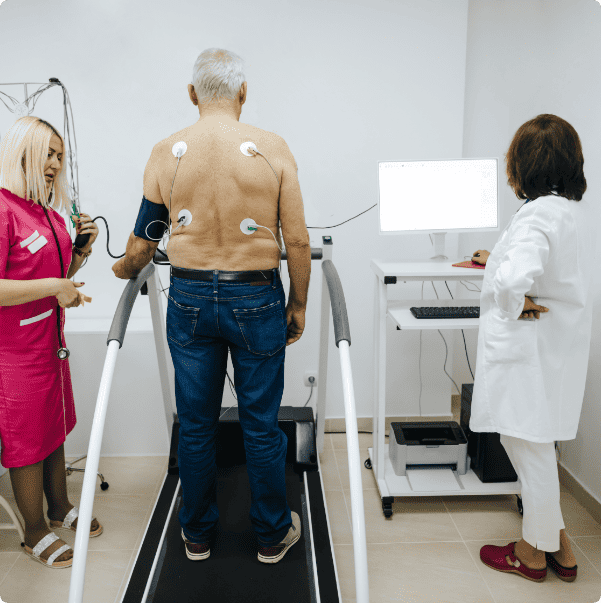
Exercise Stress Electrocardiography (ECG) is a widely used diagnostic test that evaluates how your heart responds to physical activity. This non-invasive procedure involves monitoring your heart’s electrical activity during exercise, providing valuable insights into your cardiovascular health.
How It Works:
Baseline ECG: Resting electrocardiogram readings are taken to establish a baseline of your heart’s electrical activity.
Exercise Phase: You will engage in a controlled exercise routine, such as walking on a treadmill or pedaling a stationary bike, while your heart rate, blood pressure, and ECG are continuously monitored.
Real-Time Analysis: The ECG machine records the electrical signals produced by your heart during exercise, helping identify any abnormalities or irregularities.
Why It’s Done:
Detecting Ischemia: Exercise Stress ECG is effective in detecting reduced blood flow to the heart muscles (ischemia), which may not be evident at rest.
Assessing Fitness: It provides valuable information about your heart’s response to physical stress, aiding in the assessment of your overall cardiovascular fitness.
Preparing for Your Test:
Clothing: Wear comfortable exercise attire and sneakers.
Medication: Inform your healthcare provider about any medications you are taking, as some may need to be adjusted before the test.
Fasting: You don’t need to be fasting for this test.
During the Test:
Communication: Report any symptoms such as chest pain, dizziness, or discomfort during the exercise phase to the healthcare team.
Post-Test Guidelines: There is typically no downtime after Exercise Stress ECG, and you can resume normal activities.
Results:
Your Exercise Stress ECG results will be analyzed by our expert cardiologists. A detailed report will be shared with you, and if further discussions about your treatment plan are necessary, our team is here to provide guidance and support.
Contact Us:
If you have any questions or concerns about your upcoming Exercise Stress ECG or any other cardiac services, feel free to contact our team. We are committed to ensuring a comprehensive and personalized approach to your heart health.
Electrocardiogram (ECG or EKG): Capturing the Rhythms of Your Heart
Electrocardiogram (ECG or EKG): Capturing the Rhythms of Your Heart
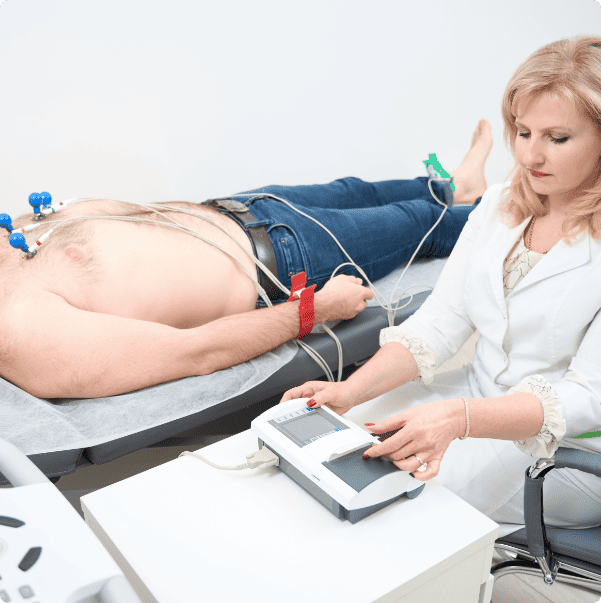
An Electrocardiogram (ECG or EKG) is a quick, painless, and widely-used diagnostic test that records the electrical activity of your heart. This essential tool helps our healthcare professionals assess the rhythm and function of your heart, providing valuable insights into your cardiovascular health.
How It Works:
Electrode Placement: Small adhesive electrodes are placed on specific areas of your chest, arms, and legs. These electrodes detect the electrical impulses generated by your heart.
Recording: The ECG machine records these electrical signals, creating a visual representation of the heart’s rhythm on a graph.
Why It’s Done:
Detecting Abnormalities: ECG is instrumental in detecting irregular heart rhythms (arrhythmias), heart attacks, and other cardiac abnormalities.
Baseline Assessment: It provides a baseline assessment of your heart’s health, aiding in the early detection of potential issues.
Preparing for Your Test:
Comfortable Clothing: Wear loose and comfortable clothing to allow easy access to the areas where electrodes will be placed.
No Special Preparations: In most cases, there is no need for fasting or any special preparations.
During the Test:
Relaxation: You will be asked to lie still and relax during the short recording period.
Communication: If you experience any symptoms during the test, such as chest pain or discomfort, inform the healthcare team.
Post-Test Guidelines:
There is typically no downtime after an ECG, and you can resume normal activities immediately.
Results:
Your ECG results will be promptly reviewed by our expert cardiologists. A detailed report will be shared with you, and if further discussions about your treatment plan are necessary, our team is here to provide guidance and support.
Contact Us:
If you have any questions or concerns about your upcoming ECG or any other cardiac services, feel free to contact our team. We are committed to ensuring a comprehensive and personalized approach to your heart health.
Ambulatory Blood Pressure Monitoring: Your Blood Pressure, Your Lifestyle
Ambulatory Blood Pressure Monitoring: Your Blood Pressure, Your Lifestyle
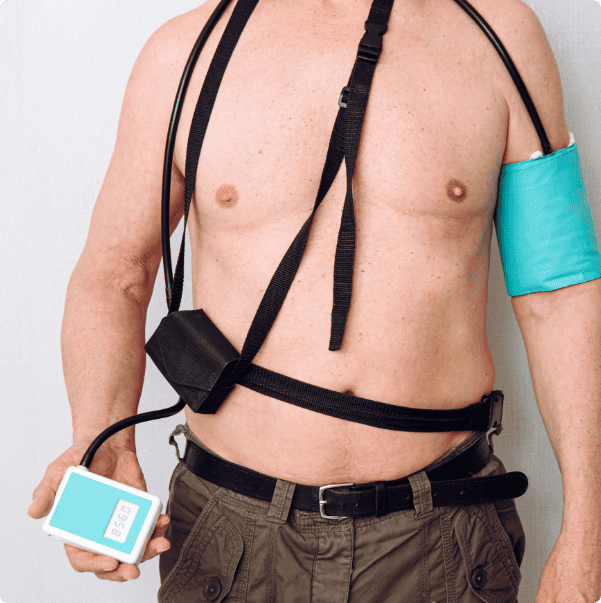
Ambulatory Blood Pressure Monitoring (ABPM) is a comprehensive diagnostic test designed to provide a detailed analysis of your blood pressure patterns over a 24-hour period. This non-invasive and patient-friendly procedure offers a more accurate representation of your blood pressure in various everyday situations.
How It Works:
Compact Monitor: A small, portable blood pressure monitor is worn on a belt or strap, connected to a cuff around your arm. It’s programmed to take blood pressure readings at regular intervals throughout the day and night.
Normal Activities: You carry on with your daily routine, including work, exercise, and sleep, while the monitor records your blood pressure at different times.
Why It’s Done:
Holistic Assessment: ABPM provides a more comprehensive understanding of your blood pressure by capturing variations in different settings, offering a holistic assessment beyond a single office visit.
Diagnosing Hypertension: It aids in diagnosing hypertension and assessing the effectiveness of medications.
Preparing for Your Test:
Comfortable Clothing: Wear loose and comfortable clothing to ensure easy application of the blood pressure cuff.
Daily Log: Maintain a record of your activities, including sleep and wake times, during the monitoring period.
During the Test:
Normal Activities: Go about your daily routine, including work, exercise, and sleep, as the monitor records your blood pressure.
Cuff Positioning: Follow instructions for proper positioning of the cuff during measurements.
After the Monitoring Period:
Return the monitor as instructed by your healthcare team.
Results:
Your ABPM results will be analyzed by our expert healthcare professionals. A detailed report will be shared with you, providing insights into your blood pressure variations and helping guide any necessary interventions.
Contact Us:
If you have any questions or concerns about your upcoming ABPM or any other cardiac services, feel free to contact our team. We are committed to ensuring a comprehensive and personalized approach to managing your blood pressure and overall heart health.
